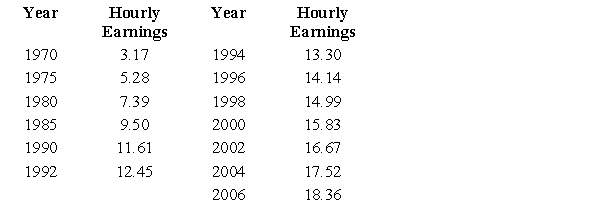Multiple Choice
Suppose that the following table shows the average hourly earnings for full-time production workers in various industries for selected years. Find the linear regression equation for hourly earnings as a function of time (with  representing 1970) . Round numerical values in your answer to four decimal places.
representing 1970) . Round numerical values in your answer to four decimal places. 
A) 
(where 
Is the number of years after 1970 and 
Is the average hourly wage)
B) 
(where 
Is the number of years after 1970 and 
Is the average hourly wage)
C) 
(where 
Is the number of years after 1970 and 
Is the average hourly wage)
D) 
(where 
Is the number of years after 1970 and 
Is the average hourly wage)
E) 
(where 
Is the number of years after 1970 and 
Is the average hourly wage)
Correct Answer:

Verified
Correct Answer:
Verified
Q83: If <img src="https://d2lvgg3v3hfg70.cloudfront.net/TB1243/.jpg" alt="If ,
Q84: The total cost (in dollars) of producing
Q85: If <img src="https://d2lvgg3v3hfg70.cloudfront.net/TB1243/.jpg" alt="If is
Q86: Find the maximum value of the function
Q87: A biologist has conjectured that the weight
Q89: Suppose that the utility function for two
Q90: If <img src="https://d2lvgg3v3hfg70.cloudfront.net/TB1243/.jpg" alt="If ,
Q91: The cost (in dollars) of manufacturing one
Q92: Suppose that the number of tons of
Q93: The material for the base of an